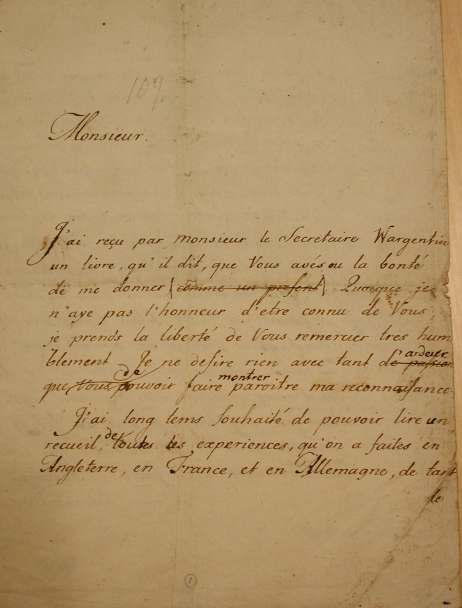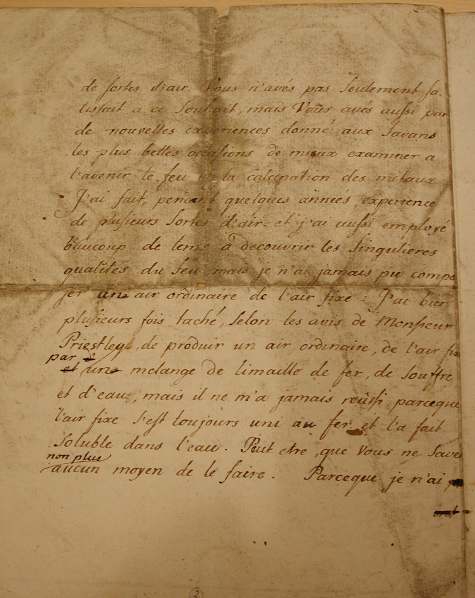Scheele's Unanswered Letter
Of all the "airs" that provided the impetus for
the chemical revolution at the end of the 18th Century, the most
important was oxygen, which provided both the basis of Lavoisier's
theory of acids and the means of "ultimate" analysis of organic
substances by combustion.
Among Scheele's papers at the Center for History
of Science at the Royal Swedish Academy of Sciences in Stockholm is
the draft of a letter he sent to Lavoisier in 1774. In this letter
Scheele, the apothecary in Uppsala, thanks Lavoisier for his book and
tries to establish a collaboration for the study of oxygen with the
well-equipped Lavoisier. Apparently Lavoisier never replied, even
though Scheele had gone to the trouble to have a friend help him
render the letter from German into French.
Scheele suggests that Lavoisier use the French
Academy's 33-inch burning glass to focus the sun's rays on silver
carbonate. Heating will generate carbon dioxide (fixed air) and
silver oxide, which decomposes (at about 340°C) to silver metal
and oxygen. If the fixed air in the collecting jar is removed by
alkali, the oxygen could support respiration or the burning of a
candle.
It is not known whether Lavoisier carried out this
experiment, or why he did not reply to Scheele. Perhaps he was
reluctant to share credit for this important discovery. He later
wrote that some months before Easter in 1775 he had prepared "a new
kind of air entirely unknown at that time". It was surely not unknown
to Scheele.
From the clarity of this first communication
describing the preparation and properties of what Scheele referred to
as "Feuerluft" (fire air) or "Vitriol air", it is clear that he
should at least share with Lavoisier and Priestly in discovering
oxygen. His laboratory notes show him preparing the gas by heating
silver carbonate in 1771-72.
|
Sir,
I have received through Secretary
Wargentin a book, which he says that you have had the
goodness to give me (as a present).
Although I do not have the honor of being known by you, I am
taking the liberty of thanking you very humbly. I desire
nothing with as much (passion) ardor as to
be able to show you my gratitude.
For a long time I have wanted to be able
to read an account of all the experiments that have been
done in England, in France and in Germany on the
many
[Wargentin, an astronomer, was secretary of the Royal
Swedish Academy of Sciences. On April 12, 1774, Lavoisier
had sent him a copy of his recently published "Opuscules
physiques et chimiques" for the Academy with another copy to
give to Scheele. Apparently Lavoisier never wrote directly
to Scheele. Scheele never corresponded with Priestly, the
third discoverer of oxygen.]
|

|
|
kinds of air. You have not only satisfied
this wish, but by new experiments you have given scientists
in the future the most beautiful opportunities to better
examine fire and the calcination of metals.
During the past several years I have
carried out experiments on several kinds of air, and I have
also spent a good deal of time in discovering the singular
properties of fire, but I have never been able to prepare
ordinary air from fixed air : I have tried many times,
following the opinion of M. Priestley, to produce an
ordinary air from fixed air by a mixture of iron filings,
sulfur, and water, but I have never succeeded because fixed
air always united with the iron and made it soluble in the
water. Perhaps you do not know a way to do this
either.
Because I do not have
|

|
|
any large burning glass, I beg you to
carry out an experiment (a trial) with yours in this way :
Dissolve some silver in nitrous acid and precipitate it with
alkaline tartrate, wash the precipitate, dry it, and reduce
it with the burning glass in your machine, fig. 8, but
because the air in this bell jar (this receiver) is such
that animals die in it and a part of the fixed air separates
from the silver in this operation, it is necessary to place
a bit of quick lime in the water where one has put the bell,
so that this fixed air joins more quickly with the lime.
This is the way that I hope that you will see how much air
is formed during this reduction, and whether a lighted
candle can keep burning and animals live in this
air it. By this experiment you will do me a
great favor. I would be infinitely obliged if you
would inform me of the result of this experiment. I have the
honor of remaining with great esteem, Monsieur, your very
humble servant.
Uppsala, the _ September,
1774.
[The letter was recopied and sent on September 30.
Sometime after 1890 it was thought to have disappeared from the papers of
Lavoisier, but if so, it has now reappeared.]
|

|
Many thanks to Anne Wiktorsson and the staff of the Center for
History of Science at the Royal Swedish Academy of Sciences for kind
hospitality and for providing access to this document.
For a full discussion of Scheele's letter and its implications,
see the source of most of these comments: Uno Boklund "A Lost Letter
from Scheele to Lavoisier", published in Lychnos
(1957) and
reprinted by Almquist & Wiksells (Uppsala, 1958). Many thanks
to Henri Kagan, who reported in 2008 that the original Scheele letter
has (re?)surfaced in the Archives of the French Académie des Sciences.
It incorporates the corrections in the draft above (except
"montrer" and "recipient") and is in a different hand.
text copyright 2003 J. M. McBride


